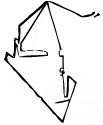 Shai Kremer, Shvil Tishtush alongside the Separation Fence, Etz Efrayim Settlement, 2004
Shai Kremer, Shvil Tishtush alongside the Separation Fence, Etz Efrayim Settlement, 2004
One more find from Paris Photo (they will keep coming, but I'll stop mentioning the source from now on), Israeli photographer Shai Kremer, whose series Infected Landscape and Desert follow the traces of all the past and present conflicts spread all over his native land.
"The scars concealed in the landscape correspond to the wounds in the collective unconscious of the country. The landscape, infected with loaded sediments of the ongoing conflict, becomes a platform for discussion."
Kremer's own words beat any other possible introduction to his images, still I want to remark how these last years have given us an increasing number of photographic works that faced social issues by showing exactly the sediments of the events on the landscape of nations, sediments of the consequences of the action of human beings, whether it is destruction, new construction, settlements, or whatever else conflicts can produce.
There was a time when photography was way more devoted to grasp these kind of events as they were actually taking place, seizing the moment; but way before then, there was another time when photography could only depict the aftermath of battles, or show wide views in the distance, summing up in a few images what was later shown in thousands of photographs and hours of TV footage.
So, it is always a pleasure to give a warm welcome back to Roger Fenton. Shai Kremer, Radar foundations Remains of a military base on top of Mount Meron Nature Reserve, 2007
Shai Kremer, Radar foundations Remains of a military base on top of Mount Meron Nature Reserve, 2007
Un'altra scoperta da Paris Photo (ce ne saranno altre, ma d'ora in poi non citerò più la fonte), Shai Kremer, fotografo israeliano i cui lavori Infected Landscape e Desert seguono le tracce dei conflitti passati e presenti lungo il territorio del suo paese.
"Le cicatrici del paesaggio corrispondono alle ferite nell'inconscio collettivo della nazione. La terra, infetta dai depositi del conflitto in corso, diventa una piattaforma per avviare una discussione."
Inutile aggiungere altro alle parole con cui Kremer stesso introduce le sue immagini; penso soltanto a come negli ultimi anni abbiamo visto sempre più lavori che affrontano temi di attualità proprio mostrando il depositarsi degli eventi sul territorio, che si tratti di distruzione, di ricostruzione, di nuovi insediamenti umani e di tutto quello che i conflitti portano con sé. Shai Kremer, from Desert
Shai Kremer, from Desert
C'è stato un tempo in cui la fotografia era molto più dedita a afferrare questi eventi mentre accadevano, cogliendo l'attimo; ma molto prima ancora, c'è stata un'epoca in cui l'immagine fotografica poteva solo raccontare ciò che restava di una battaglia, oppure mostrare ampie vedute da una certa distanza, dovendo riassumere in poche immagini ciò che in seguito è stato raccontato con migliaia e migliaia di fotografie e con ore di immagini televisive.
Ragion per cui è sempre un piacere poter dare il bentornato a Roger Fenton. Roger Fenton, The Valley of the Shadow of Death 1855 © Library of Congress, Print & Photographs Division
Roger Fenton, The Valley of the Shadow of Death 1855 © Library of Congress, Print & Photographs Division
Friday, November 27, 2009
Sediments
Labels:
Paesaggi/Landscapes
Subscribe to:
Post Comments (Atom)

No comments:
Post a Comment